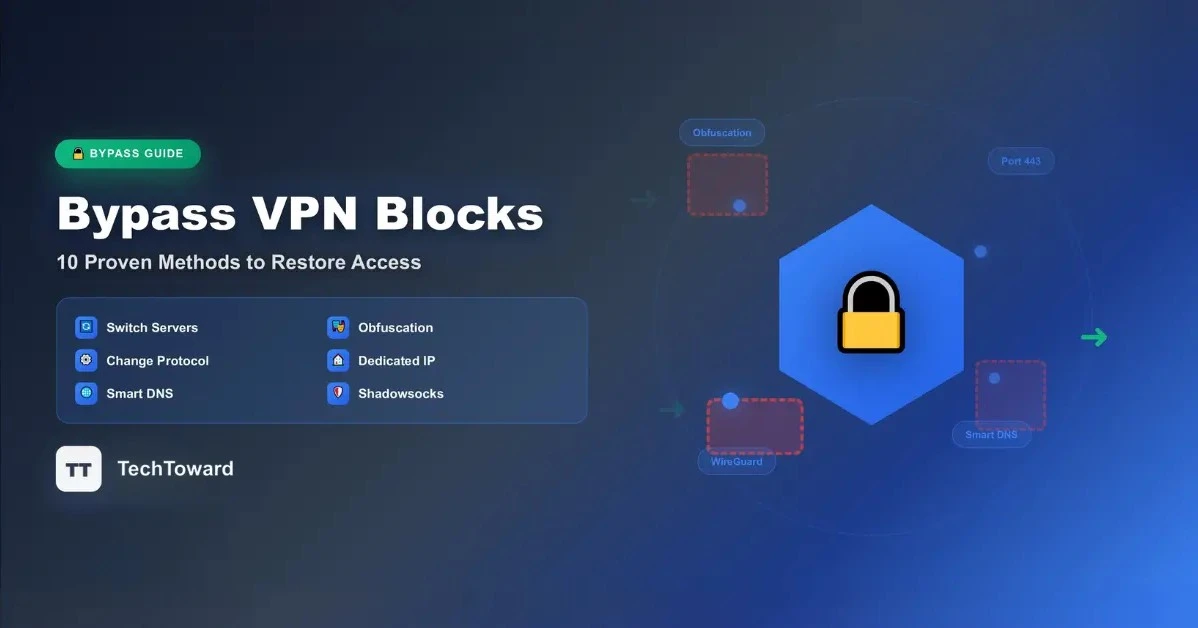Bypassing VPN blocks and restrictions can seem difficult, but with the right tools and knowledge, you can restore access to websites and services quickly. Whether you’re traveling, working remotely, or accessing region-locked content, understanding how VPN detection works—and how to overcome it—helps ensure seamless, private browsing.
Why VPN Blocks Exist
Many organizations and platforms block VPNs to control access or comply with regional restrictions. Streaming services like Netflix, Hulu, and BBC iPlayer detect and block VPN traffic to enforce content licensing rules. Similarly, schools, offices, and certain governments restrict VPN use to control what users can access online.
To enforce these blocks, systems use methods like IP address blacklisting, deep packet inspection (DPI), DNS filtering, and port blocking. When a VPN is detected, users may face slow connections, proxy errors, or total access denial.
How VPN Detection Works
Understanding how VPN detection operates helps you choose the best bypass strategy:
- IP Address Recognition: VPN servers often share IP addresses among many users. When hundreds connect from the same IP, it’s easy for websites to flag it as a VPN node.
- Deep Packet Inspection (DPI): DPI analyzes network data packets. Even if encrypted, VPN traffic has identifiable patterns.
- DNS Leaks: When DNS requests bypass the VPN tunnel, your real IP and location may be revealed.
- Port Blocking: Some firewalls block common VPN ports like UDP 1194 or TCP 1701 to stop connections entirely.
1. Switch to a Different VPN Server
The simplest fix is to switch servers. Many premium VPNs rotate IPs regularly to avoid detection. If one server or region is blocked, connect to another. Providers like ExpressVPN, NordVPN, and Surfshark offer thousands of rotating servers optimized for bypassing detection.
2. Use Obfuscated Servers
Obfuscation disguises VPN traffic as normal HTTPS activity, making it nearly impossible for DPI systems to detect it.
Examples:
- NordVPN: “Obfuscated servers” option
- ExpressVPN: Built-in automatic obfuscation
- Surfshark: “Camouflage Mode”
Enable obfuscation in your VPN app’s advanced or specialty settings. It’s especially useful in restrictive environments like schools, offices, or heavily censored countries.
3. Change Your VPN Protocol
Switching protocols can help your VPN evade detection:
- WireGuard: Fast, modern, and lightweight. Its flexible port usage makes it hard to block.
- OpenVPN TCP on Port 443: Uses the same port as HTTPS, blending with normal web traffic.
- IKEv2/IPsec: Works well on mobile networks and often bypasses strict filters.
- SSTP: Uses SSL/TLS over port 443, highly resistant to DPI.
Experiment within your VPN’s settings to see which protocol performs best for your network.
4. Get a Dedicated IP Address
A dedicated IP—used only by you—reduces the chance of blacklisting since it doesn’t appear on shared VPN IP databases. Premium providers offer dedicated IPs for a small monthly fee. These IPs appear as normal residential connections, making them ideal for streaming or remote work.
5. Configure Custom DNS Settings
A DNS leak can reveal your VPN usage. To prevent this:
- Use your VPN’s DNS servers or public options like Cloudflare (1.1.1.1) or Google DNS (8.8.8.8).
- Ensure “DNS leak protection” is enabled in your VPN app.
- Manually adjust DNS settings on your device if necessary.
This ensures all DNS queries stay within the encrypted tunnel.
6. Use Smart DNS Services
Smart DNS reroutes DNS requests through servers in other regions, tricking websites into thinking you’re elsewhere. It doesn’t encrypt your data, so it’s not a full VPN replacement, but it’s excellent for streaming geo-blocked content on devices that don’t support VPNs (like smart TVs and consoles). Many VPNs bundle Smart DNS with their subscriptions.
7. Manual Configuration and Port Forwarding
Advanced users can manually configure VPN connections to use non-standard ports, such as:
- Port 443 (HTTPS) – Almost always open
- Port 80 (HTTP) – Common for web traffic
By forwarding or redirecting your VPN through these ports, you can often bypass strict firewalls. Most VPN providers provide step-by-step guides for manual setup on routers and desktop clients.
8. Combine VPN with Tor or a Proxy
For high anonymity and bypassing severe restrictions, combine multiple tools:
- Tor over VPN: Connect to a VPN first, then use the Tor browser. Your ISP sees only VPN traffic, not Tor usage.
- VPN over Tor: Connect to Tor first, then a VPN—offering greater privacy but slower speeds.
- VPN + SOCKS5 Proxy: Some VPNs include SOCKS5 proxies for extra routing layers that help bypass stubborn blocks.
Though slower, these combinations significantly improve bypass capabilities and privacy.
9. Use Shadowsocks
Shadowsocks is an open-source encrypted proxy built to defeat censorship, especially in restrictive countries like China. It disguises VPN traffic as ordinary web traffic, making it extremely hard to detect or block.
You can:
- Use a VPN provider that includes Shadowsocks (e.g., Surfshark or Astrill), or
- Set up your own Shadowsocks server if you’re technically inclined.
It’s lightweight, fast, and very effective against sophisticated firewalls.
10. Choose a VPN with Residential IPs
Residential IP VPNs route your traffic through IPs assigned to real homes instead of datacenters. Because they look like ordinary user connections, they’re almost impossible to block.
Services like Bright Data and Smartproxy specialize in residential IPs, while some premium VPNs are beginning to integrate this option. Although costlier, it’s one of the most reliable methods for bypassing detection.
Choosing the Right VPN for Bypassing Restrictions
Not all VPNs are built equally. Look for the following when choosing one:
- Large Server Network: More servers = more available, unblocked IPs.
- Regular IP Rotation: Constantly changing IPs helps stay ahead of blacklists.
- Obfuscation Features: Essential for avoiding DPI and censorship filters.
- Multiple Protocol Options: Allows flexibility in evading different block types.
- Smart DNS and Dedicated IP Support: Improves streaming and stability.
- 24/7 Support: Helps identify which servers currently work with specific services.
- Money-Back Guarantee: Lets you test before committing.
VPNs like ExpressVPN, NordVPN, and Surfshark excel in these areas due to frequent IP refreshes and built-in obfuscation.
Troubleshooting Common Problems
Even strong VPNs occasionally face blocks. Try these steps if yours stops working:
- Clear Cookies and Cache: Websites can store location data even after changing IPs. Use private/incognito mode for a clean session.
- Disable IPv6: Some VPNs don’t route IPv6 traffic, leading to leaks. Disable IPv6 in your device’s network settings.
- Check for DNS or IP Leaks: Use tools like DNSLeakTest.com or ipleak.net to confirm your VPN hides your true IP.
- Update the VPN App: Updates often patch detection vulnerabilities and add new servers.
- Contact Support: Premium VPNs often provide live recommendations for working servers.
Legal and Ethical Considerations
While VPN use is legal in most countries—including the US, UK, Canada, and Europe—some nations (like China, Russia, Iran, and UAE) restrict or ban VPNs. Always verify local laws before using bypass methods.
Bypassing blocks usually violates platform terms of service, not laws. For instance, Netflix may temporarily restrict access but won’t take legal action against users. Use VPNs responsibly and respect copyright and licensing agreements.
Frequently Asked Questions
Why is my VPN suddenly blocked?
Platforms frequently update blacklists and detection systems. Switching to another server or enabling obfuscation typically fixes the issue.
Can free VPNs bypass restrictions?
Rarely. Free VPNs have limited servers, easily blacklisted IPs, and no obfuscation. They may also log data or inject ads. Premium VPNs are more reliable and secure.
What’s the best method for Netflix?
Use a reputable VPN with dedicated streaming servers (like ExpressVPN, NordVPN, or Surfshark). Enable obfuscation if available and switch servers when necessary.
Will bypassing blocks reduce my speed?
Some methods—like obfuscation or Tor—slow connections slightly due to encryption layers. However, newer protocols like WireGuard maintain fast speeds even when bypassing restrictions.
Is bypassing VPN blocks legal?
Yes, in most countries. However, it may breach a site’s terms of service. Always follow local laws and use VPNs ethically.
How do I test for leaks?
Use free tools such as DNSLeakTest.com or your VPN provider’s built-in test. They reveal if your real IP or DNS requests are visible outside the VPN tunnel.
Conclusion: Regain Control of Your Online Freedom
Bypassing VPN blocks and restrictions is entirely possible using the right combination of tools and strategies. Start with easy fixes—switching servers, changing protocols, or enabling obfuscation. For tougher blocks, consider dedicated IPs, Shadowsocks, or residential IP VPNs.
The most critical factor is choosing a premium VPN provider that continually refreshes its IPs, supports obfuscation, and adapts to new detection methods.
VPN blocking is a constant technological arms race: as detection methods evolve, so do bypass strategies. Staying informed ensures your privacy, access, and freedom remain intact—wherever you are.
Your digital freedom is worth protecting. Choose a reliable VPN, apply these techniques, and enjoy unrestricted, secure access to the global internet—on your terms.


